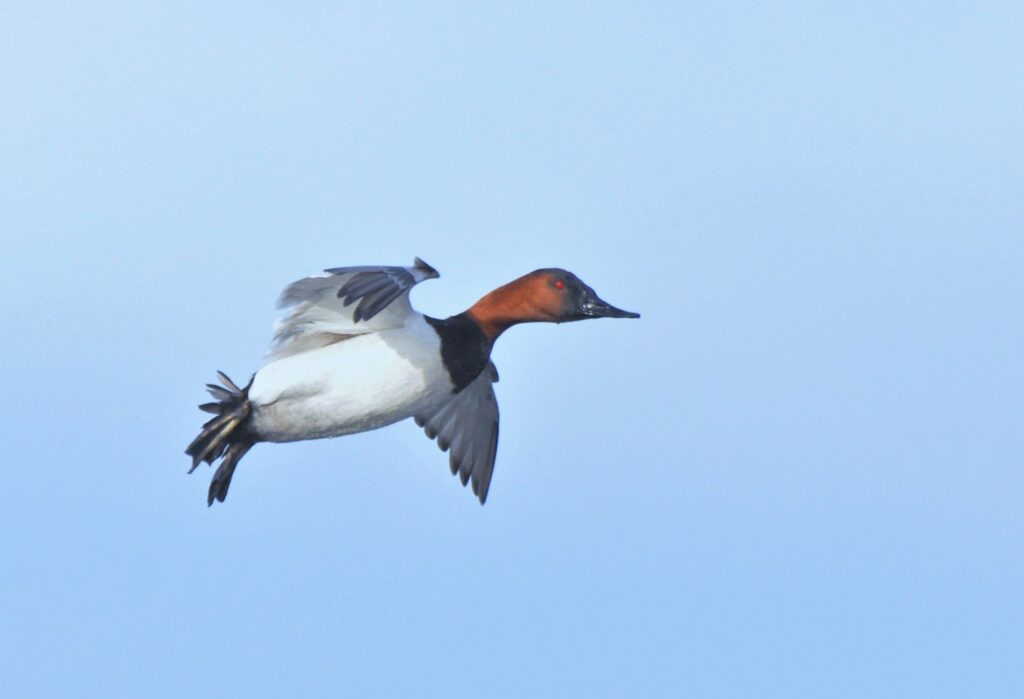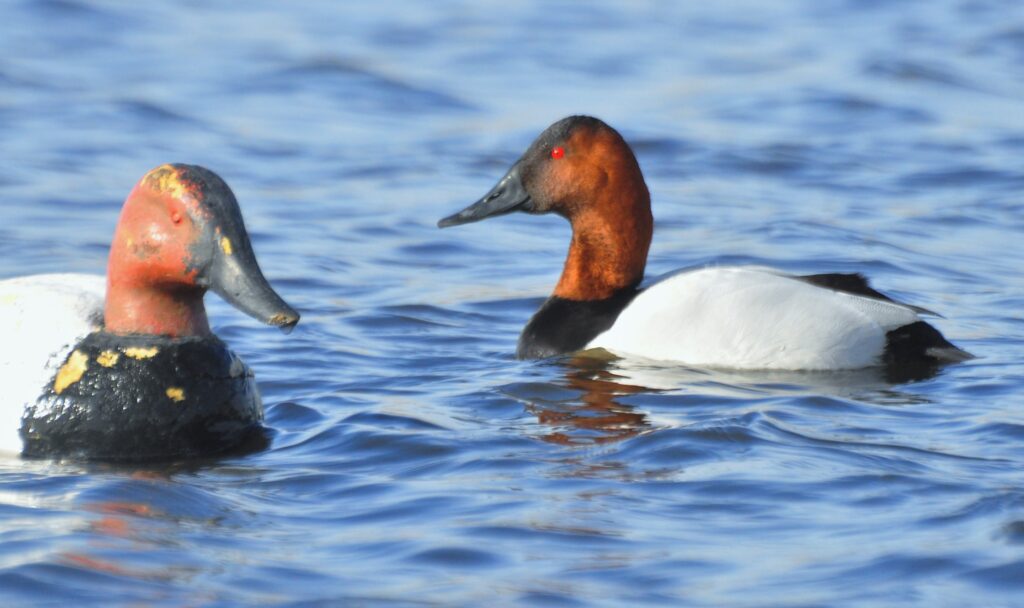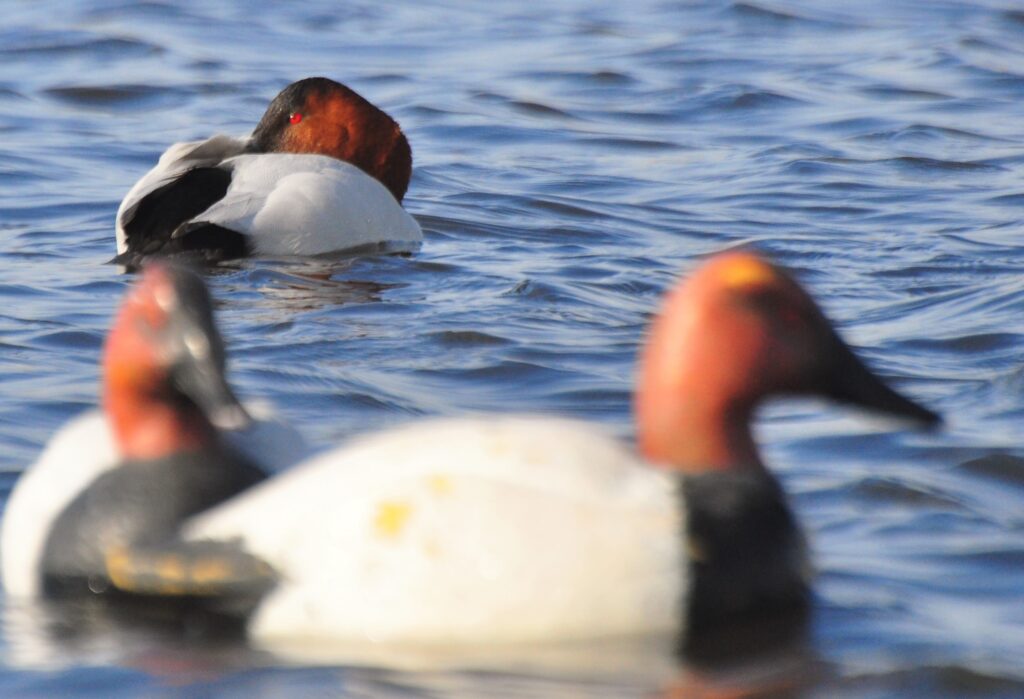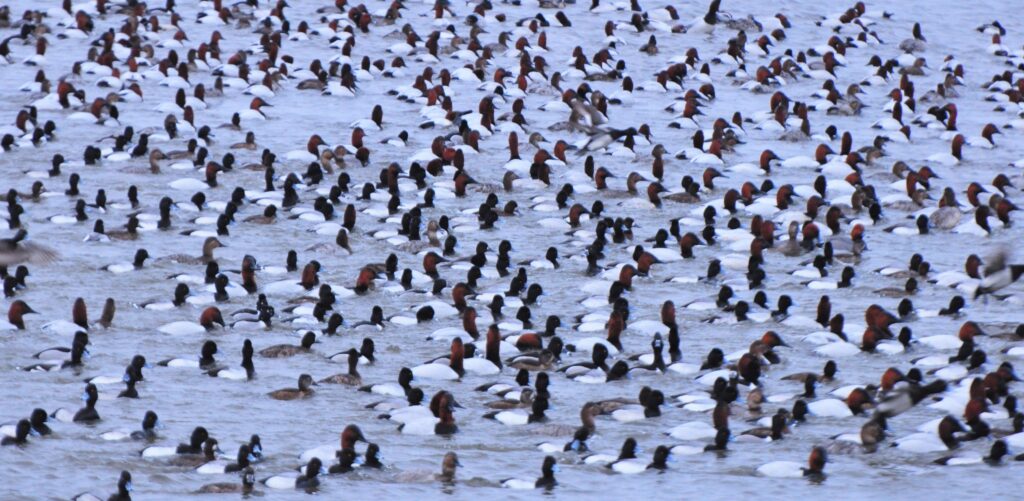Photography courtesy of Lowell Washburn, all rights reserved.
Luring flocks of wild ducks and geese into a well-placed spread of decoys – or at least making the attempt — is one of my favorite outdoor pastimes. Doesn’t really matter if it’s spring or fall; or whether I’m armed with a digital camera or loaded shotgun. It’s being there that counts. For me, there are few sights or sounds that compare with the early morning roar of set wings and the audible splash of compact bodies as birds pitch into the spread.
We were now standing at the tail end of March, and it appeared as if spring really was on its way. During the night, a howling northwest wind had chiseled ever widening patches of open water into the rotting winter ice. A scattering of northbound ducks were already dotting the surface of the deeper airholes. Although they had yet to make an appearance, I knew that migrating canvasback ducks would soon arrive.
It’s no secret that the regal canvasback is one of my favorite webfoots. I’m not alone in my thinking. Serving as the literal centerpiece for the era of 1800’s market gunning, no waterfowl species has a longer or more colorful association with humans that this undisputed King of Ducks.
Offering an abundance of natural duck foods, the sprawling 2,300-acre Union Hills Waterfowl Production Area is one of my favorite locations for meeting with The King. Today would be the season’s first outing. Getting an early start, I packed my gear and headed for a sheltered bay on one of the area’s larger wetlands. Except for stumbling into a surprise muskrat run, the hike into the thawing bay went smoothly. By the time the sun cleared the horizon I had placed a nice spread of decoys – mostly canvasbacks – and was settled into my hastily constructed, makeshift blind.
The skies were clearing, and the wind had moderated. The light was perfect, and things were looking good for photos. But as the morning advanced, it became obvious that I had jumped the gun. The stars of my would-be photo session had yet to appear. The beautiful canvasbacks were a no show.
And then I spotted it — a lone duck etched against the southern skyline. At this point, the bird was little more than a winged dot. But the clues to its identity were undeniable. The combination of size, shape, wing beat, and the way the duck powered into the north breeze left no room for doubt that feathered royalty was on its way.

Lone Migrator — Setting his wings and dropping the webbed landing gear, the drake passed in an audible rush of sound.
In less than a minute, the big diver had arrived over the wetland where I sat crouched beneath my bulrush hide. The bird was indeed a canvasback – a stunningly beautiful drake, resplendently complete with the species’ distinctive white back, bull neck, russet head, elegantly sculpted bill, and blood red eye.

At the Decoys – The drake paused to assess my counterfeits.
Canvasback ducks are famously gregarious, feeding and resting in great open water rafts. And although I’ll never know the reason this drake was alone, it was obvious that he didn’t intent to stay that way. Setting his wings and dropping the webbed landing gear, the duck passed in an audible rush of sound. Landing downrange of the decoys, he immediately turned and came swimming back. Eager for companionship, the drake was stroking for all he was worth, literally pushing a shallow wake ahead of him. Arriving at the spread, the ‘can ceased paddling while pausing to assess my counterfeits. Determining that all was well, the duck relaxed.
It quickly became apparent that the ‘can must have been on the wing for a long while; perhaps he had flown all night. Instead of capitalizing on the lush underwater buffet of aquatic roots and seeds, the drake simply tucked his bill into the feathers of his back and immediately fell asleep. Holding in place among the decoys, the duck’s only visible sign of consciousness was an occasional opening of his brilliant ruby eye. Upon seeing no danger, it was quickly back to sleep.

Sleeper – The drake had apparently been on the wing for a long while. Arriving at the decoys, the duck simply tucked his bill and immediately fell asleep. The only sign of consciousness was the occasional opening of his ruby eye.
The season was rapidly advancing. Within 48 hours, the waters would become covered with more than a dozen species of migrating fowl, including hundreds upon hundreds of northbound canvasbacks. But as far as today’s outing was concerned, this would be my sole visit from the King of Ducks.

Northbound — Within 48 hours, the waters would become covered with more than a dozen species of migrating fowl, including hundreds upon hundreds of northbound canvasbacks.
So, was crawling out of bed during the wee hours and making my way into the dark marshland to set decoys for the meager opportunity to observe and photograph a single canvasback duck worth the effort? Absolutely! I mean how often does a person receive a private audience with The King?

 Susan Judkins Josten
Susan Judkins Josten Rudi Roeslein
Rudi Roeslein Elyssa McFarland
Elyssa McFarland Mark Langgin
Mark Langgin Adam Janke
Adam Janke Joe Henry
Joe Henry Sue Wilkinson
Sue Wilkinson Tom Cope
Tom Cope Kristin Ashenbrenner
Kristin Ashenbrenner Joe Wilkinson
Joe Wilkinson Dr. Tammy Mildenstein
Dr. Tammy Mildenstein Sean McMahon
Sean McMahon